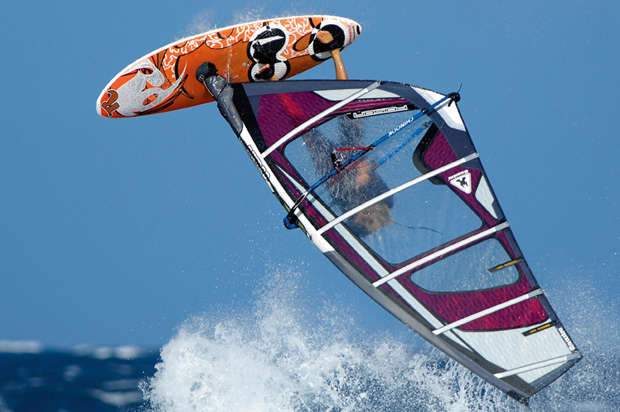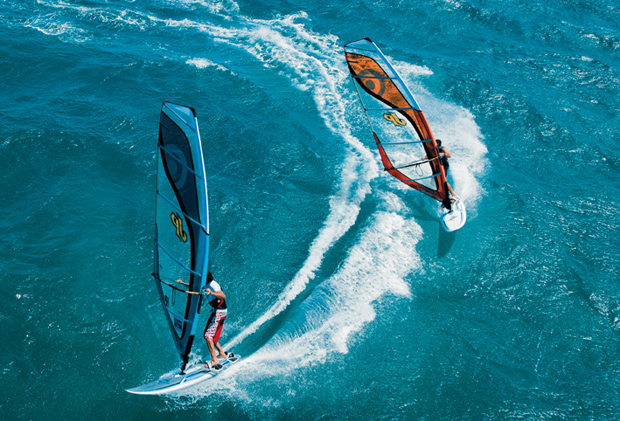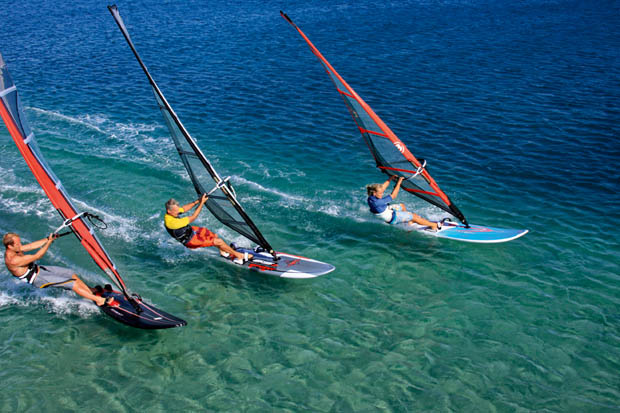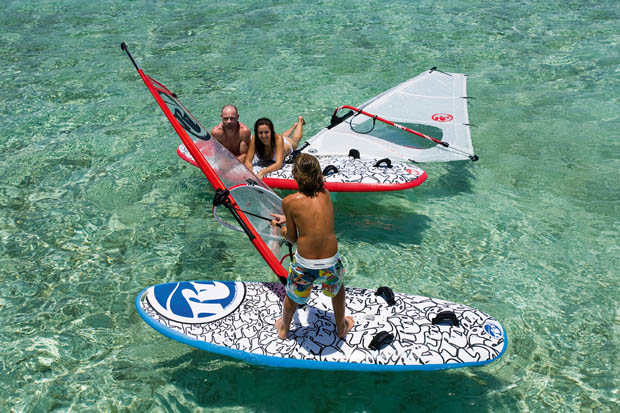The BOARDS Test Team carry out an in-depth examination of the top freestyle and freemove contenders in the 62-65cm width (97-105L volume) bracket, and look at why you might choose one rather than the other. Pix by Andy Joswik…
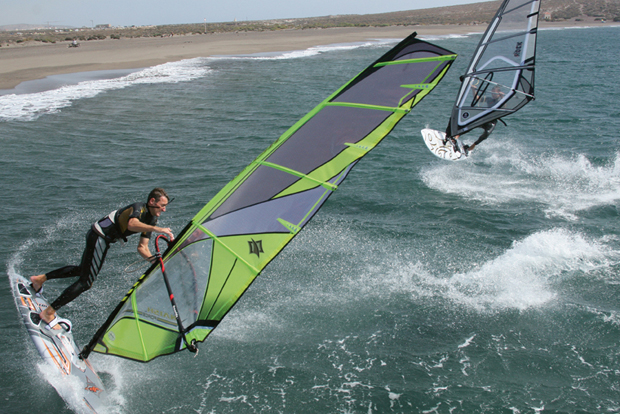
This size of board is a very useful all-round size that is (generally) ideally suited to sails between around 5.5 and 7.0m, and thus work in a wide range of conditions from the bottom of a Force 4 up to a solid Force 5. There is thus a very wide range of options in this size, since you can enjoy pretty much any sort of sailing in this wind band, be it freeride, freemove, freestyle, even wave. Thus most boards in this sector of the market attempt to offer some degree of crossover performance. Last year we had a good look at the difference between freerides (boards focussed primarily on comfortable, enjoyable straight line blasting and gybing) and the equivalent sized freemoves (slightly more wave / manouevring performance) in this size. This time round we have chosen to examine the differences between the freemove and freestyle offerings on the market.
Freemove vs Freestyle?
Freestyle boards have been through various phases of evolution since their first appearance on the scene at the start of the new millennium, varying between extremely specialist and extremely all-round. So where is the market at for 2008? Going by the boards on this test, there is no specific factor nowadays that distinguishes a freestyle board from any other. You are most likely to recognise one by its very inboard straps and some kind of duck-tail (or now more commonly a slab tail). They do also tend to be wider, shorter and less pointy at both ends than most boards. However, the differences between modern freestyles and freemoves are not that great (see comparison chart on p44) and plenty of examples can be found from either camp to contradict any single distinguishing factor you might choose. The reason for this is that freemove design has closely followed the lead of freestyle design over the past decade in respect of the two most important characteristics: increasing width and decreasing length. So there is now little clear blue water between the two camps.
Fin:
All the proficient freestylers testing these boards set one physical characteristic well above every other as being the single most helpful to good freestyle, and it’s simply fin size. All agreed that everything else pales into insignificance compared to the difference between a small freestyle fin (18-22cm) and any 28-32cm freemove fin or even, for that matter, any 24-26cm freestyle fin. So in effect it’s very simple to convert your freemove into a very serviceable freestyle – simply insert a small (18–22cm) fin! And this is in essence the main finding of the test:
There is not much difference between a standard freestyle board and standard freemove board in terms of suitability for modern aerial freestyle. In our testing any intrinsic advantage of the freestyle board could be totally reversed by fin choice. In other words, a freemove with a decent small fin is much better at freestyle than most of the freestyle boards with their supplied fins. OK, if both boards have the same fin then generally the freestyle will be better for freestyle, but even this is subject to qualification. It was not true of all the boards and it is quite dependent on windstrength and conditions. Freestyles tend to offer most help when there isn’t a lot of wind available or if the water’s quite choppy. If it is windy but reasonably flat there’s a lot to be said for the narrower nose and tail and reduced bulk of the freemove.
Freestyle vs Freemove?
So the obvious question then becomes: does it work both ways? Is a freestyle very nearly as good as a freemove for more all-round recreational performance? Well, the answer is indeed yes, in many cases. The F2 Chilli, Fanatic Skate, Goya X1 and JP Freestyle, although varying in preference for wave-biassed or flatter water conditions, all make very decent all-round boards that could appeal to just about anybody. Generally, freestyles only harm their all-round performance by omission or by including minor specialisms (that are often of questionable use for freestyle anyway!) The obvious omission is outboard strap options, which were included on only two freestyle boards. This immediately cuts down their straight line sailing potential (although many recreational sailors don’t mind them inboard, if they’re not too bothered about trying to blast at maximum speed). Lack of dome underfoot to provide comfort over long reaches was another issue in many cases,although the Mistral Joker proved that a freestyle can be better in this area than the best freemoves. Examples of minor specialisms would include the long, low duck-tail of the Tabou which slightly inhibits release onto the plane, the bulk of the bigger slab tails which slightly inhibit carving grip, the extremes of the wider noses and tails which slightly inhibit top speed and agility, and the flatter noses which slightly inhibit wave (and jumping) suitability. None of these, on their own, will disqualify an otherwise good freestyle board from still displaying very good all-round performance unless they particularly impact on an important characteristic for the potential owner. As they accumulate, however, they do.
Conclusion
So the bottom line is that the best freestyles for all-round performance probably have made some very minor sacrifices for specifically freestyle suitability, but potentially remain nearly as good for all-round performance as a freemove. It’s a significant ‘nearly’, though. In practice most didn’t quite compete with the best freemoves and the majority of freemoves were better allrounders than the majority of freestyles. So although it ultimately comes down to the individual board, we would still end up generally recommending freestyle boards only to buyers who wholeheartedly desire to practice newschool freestyle pretty much to the exclusion of all else. And if this is you, then the good news is that your new freestyle board will be pretty good for all-round sailing too. For anyone else though – and this includes advanced sailors who very much want to learn vulcans and such – the freemove is likely to put more ticks in more boxes. Just buy yourself a decent and appropriately sized freestyle fin, find some flat water and your success with the grubby, vulcan or willy skipper will be down to you, not the board.
FREESTYLES – THE TEST
This test taught us that there is nothing magical about a freestyle board. The designers don’t sprinkle them with freestyle fairy dust. They are basically just ordinary windsurf boards that are slightly shorter, wider and more voluminous than normal. Small design variations separate them but mostly they all do a similar job. When we asked people for their favourites at the end of the test none of the sailors felt really strongly and most said that they would be quite happy with most of the boards. Most also said that they would be almost equally happy with one of the better freemove boards.
The boards did, however, differ slightly in their strengths and weaknesses. Given decent wind and flattish water they are nearly all brilliant for freestyle. They separate out a bit when you try and use them in particularly marginal winds or else in choppier water or if you want to take them into small waves to try wave freestyle moves like shuv-its, ponches, shakas… The other factor that starts to separate them is versatility. There is no such thing as a freestyle board that also works brilliantly for freeride and wavesailing, but many of them cross over pretty well into one of these disciplines. So pretty much whichever you buy will give you all the potential you need for breaking out the moves in good conditions. Choosing the right one depends on suiting its strengths to the particular conditions you expect to use it in.
FAVOURITE FREESTYLES
Seven of the eight freestyle boards here work really well, each with its particular style and strengths – but three or four boards did seem to get used a bit more often than the rest. The F2 Chilli was certainly one of those. It is extremely light and lively and offers a good combination of pop, slide and spin. It is quite specialist as isn’t great for long, comfortable blasts, and the nose is really very low for waveriding. However, it is one of the most enjoyable to simply ride around on as it feels quite fast and exciting and very ready to be thrown around. Of all the boards it seemed the most likely to encourage the newcomer to attempt tricks in ordinary freestyle conditions. The Fanatic Skate was another favourite. It’s another very light board that’s very quick to get planing. It doesn’t feel much like a freestyle board and this is largely its strength. The tail is relatively narrow and not thick, allowing good carving and grip at speed. It blasts in comfort much like a freeride and develops much better than average speed. It therefore excelled for powered up freestyle, allowing dynamism with control. The downside is that it doesn’t slide and spin quite as freely as the wider, flatter boards. The extra string to its bow is that with its nonspecialist hull and outboard straps it’s the only freestyle to really offer proper crossover performance. Change the fin and strap positions and you really can go from freestyle to proper freemove / freeride. The best freestyle for stronger winds and chop was probably the Mistral Joker. A big board and not the best for lighter winds but very easy to pop and slide, and very stable. It has the feel of a very large waveboard and is another that makes it very easy for freestyle beginners to get up and round vulcans. Although big, the rockerline makes it very sympathetic for use in proper waves and it jumps well and should be excellent for low powered waveriding, giving it excellent medium wind freestyle / light wind waveboard crossover appeal. The RRD Twin Tip is probably the most specialised freestyle board and this is immediately obvious from the fin, which was by far the best. Being so short, wide and flat makes it feel quite slow and not great for crossover sailing for waves or freestyle but it really does get going in very little wind and spin and slide brilliantly. It should open up wider horizons for competent freestylers and lighter wind freestyle than any other board on test and will help less committed sailors to finish off poorly initiated moves. The Tabou Freestyle, JP Freestyle and Goya X1 were also all very good boards and all had their admirers. For the full lowdown on their particular strengths check out the individual write-ups.
SIZE
Freemoves:
The golden rule for buying freemoves or freerides is to get a board to suit the biggest size of sail you will be regularly using it with. The freemoves on test here could mostly be used happily with sails up to about 7.0m but were probably ideal with around 6.5m. Bodyweight should only enter the equation if you are either early intermediate and unsure about waterstarting and sailing low volume boards off the plane, or if you want to increase the freestyle (or non-planing) potential. For achievable uphauling you need to keep no less than 20L over bodyweight in kg (e.g. minimum 100L board for an 80kg sailor). For freestyle potential read on…
Freestyles: One of freestyle’s myths is that the ideal time to practice it is in marginal winds. Actually if the wind isn’t quite strong it’s hard to get pop and the bigger sails needed to get planing aren’t easy to manipulate. Good freestylers like the wind to be solid, thus allowing them to take one size smaller a sail than they might use for burn-&- turn. Our freestylers of between 72 and 78kg would try hard not to take out a 6.3m even in lighter winds, preferring to be quite underpowered and occasionally not planing with a 5.9m.
The board, on the other hand, works in the opposite way. Whereas normally in 5.9 weather you might ideally take out a 90L board of about 60cm width or smaller, for freestyle the board needs to be a good size bigger. This is partly to ensure easy planing but also to offer sufficient width for easy slide and to keep the board buoyant when not planing or coming out of moves quite slowly while still in the straps.
These 63-65cm, 100L boards seemed a perfect size for 73-83kg sailors as a moderate to medium wind freestyle board. None of our testers (72-78kg) were in the least bit tempted to go up a size, and in fact the smaller boards (63cm) felt like a better compromise of float to manoeuvrability for their weight. Bigger boards become harder to pop and have greater resistance to being thrown or spun around, although they will slide more easily and forgive clumsiness coming out of a move. Annek, at 63kg, was finding most of the test boards a bit large. Very few average weight freestyle sailors actually go down the big freestyle board with a 7.0m route. By and large big freestyle boards are for big sailors, not light winds.
Most of our freestyle testers stated that, in medium to stronger winds, despite having access to freestyle boards they were more likely to take out and perform freestyle on an 85L freestyle-wave. So the formula is fairly simple. For freestyle you want to take a board that is one size up (c. 2-3cm / 10L) from what you would otherwise be using for wave, bump-&-jump or burn-&-turn use. The sail, on the other hand, might be a size smaller.
FREEMOVES – THE TEST
Much as it may be in our interest as testers to say otherwise, the truth is that there is less and less to choose between these freemoves with each passing year. This year every board planes reasonably early, feels pretty good in a straight line and gybes well. There is no board here that can’t perform all the freemove basics well and be enjoyable doing so.
Do-it-all boards:
As a genre we find the versatility of these freemoves very impressive. For most sailors the majority of their usage will be with 5.5-6.5m rigs, but most will also not only give pretty good light wind early planing blasting with 7.0m sails if required yet stay reasonably controllable with much smaller. The water state is really the limit of their high wind use because being well in excess of 60cm wide the modern freemove does get quite bouncy in chop. Find flat water (or waves with flats between) and they’ll take just about anything. And within their 5.5-6.5m optimum they do it all:
• They are just floaty and stable enough to allow light wind cruising or non-planing freestyle for sailors up to about 80kg.
• They plane up early and easily.
• They are small enough to be really fun and involving to sail when planing, turning fast and tight.
• They really can be used for advanced freestyle to the extent that about half were very nearly as good as the freestyle boards themselves if you get yourself a decent freestyle fin.
• Although quite large for the average weight sailor, most are well at home in smallish waves for bump-&-jump with some stretching that to being credible lighter wind waveboards.
FAVOURITE FREEMOVES
We could actually recommend all of these boards to most buyers so no favourites as such from this test, but here are a few of the highlights of why particular boards did catch our imagination.
Mistral have come from left-field providing a Syncro that is quite unlike any that have gone before it. It was clearly the fastest of the freemoves, outstanding for crisp blasting and smooth, tight, powerful gybing in all water states, and good for bump-&-jump as well.
The Fanatic Freewave is unchanged and still one of the most responsive and best suited to wave and freestyle use. It is very agile, carving very tight for its size and appeals strongly to more advanced sailors looking to go beyond burn and turn.
The Naish All-Terrain has similar agility and wave suitabilty, feeling very much like a large freestyle-wave.
The Tabou 3S is great fun to sail. So short and wide and loose. It is beautifully smooth yet lively to ride and easy to turn and jump. The F2 XTC has a slightly similar feel. Buoyant and loose if not quite as manoeuvrable but is very early planing and very sprightly in moderate winds.
The RRD Freestyle Wave is very versatile and very smooth and easy in a wide range of conditions.

FINS
Fins aren’t a side issue to the freestyle show – they are the main issue! The current position is that most freestylers end up making their own fins by crudely cutting down bigger fins with angle grinders and saws. How mad is that?!? We found it astonishing that only one freestyle board came with a fin that was really suitable for purpose. All the others were too big and made ordinary sailing really easy but freestyle difficult. Freestyle is rendered much, much easier if the fin is small, in our view between 16 and 22cm depending on fin shape, sailor weight and windstrength. Whereas the wide 24-26cm fins provided with the freestyle boards were very unhelpful for new-school moves. What’s needed is a fin that has just enough lift to get you upwind fairly well and grip in the carve to stop you breaking out or drifting when not required, at the minimum possible size.
The problem with homemade fins is that they tend to be too stiff and break out too easily and unpredictably. You want the confidence of knowing that your fin will break out when kicked out (or on landing from pop) but not under reasonable constant pressure when pointing or carving. So efficient fin design is very important, but is simply not being addressed by the manufacturers, who seem to be providing fins for freemove sailors.
As you can see from the picture of the freestyle fins, there’s a huge difference in size between the smallest (right) and the rest. In order to test these boards all the ‘expert’ freestylers used the boards with their own freestyle fins as this was the only way to get a true comparison of comparative capabilities. The ridiculous truth though is that all freestylers have come to accept this situation as a ‘given’ and routinely don’t expect to use the fin the board comes with for freestyle. Now that RRD have come out with a really good freestyle fin, courtesy of the Maui Fin Company, hopefully this situation will change.
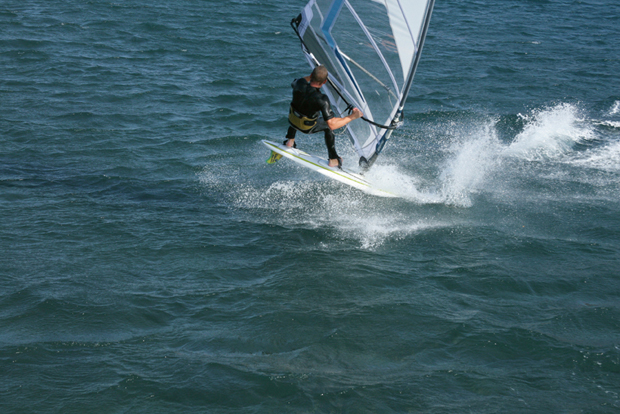
SLIDE, SPIN AND POP
These are the holy trinity of the ultimate freestyle board and words you will read a lot in these pages. Pop is the most obvious; it’s the ability of the board to get airborne. Light weight helps a lot and not having too long a flat section seems to help. People talk about volume in the tail helping which must be true to a point but actually, too much width and volume can also be counterproductive. An early 2cm point (short planing flat) does seem to help but this also slows planing and there can be no pop without speed. Vee may also help as it gives extra lateral grip as you depress the board before the pop. So pop remains a bit of an enigma. Some boards seem blessed with it in abundance but it is not exactly clear why.
Slide and spin are not quite synonymous. For example, in a vulcan you need good slide since the board is turned in the air and when it lands it needs to slide backwards. In a flaka the board isn’t moving very fast (or sliding much) at all but needs to spin quickly and easily. A move like a spock combines slide and spin since the board needs to do both at once.
Slide is certainly helped considerably by width, particularly in the nose and tail. A thick slab or duck-tail must also help by preventing the rails from digging in if the execution of a move is not slick, particularly if the water isn’t that flat. This is why waveboards can be freestyled effectively in the flat water between waves but don’t work so well in chop.
Spin is principally helped by having a smaller fin since it usually has to ‘break out’, or cavitate, before the spin can happen. However, other factors certainly help. Hard release edges seem to help as does a low quantity of vee. Also the shorter and higher rockered boards tend to spin better.
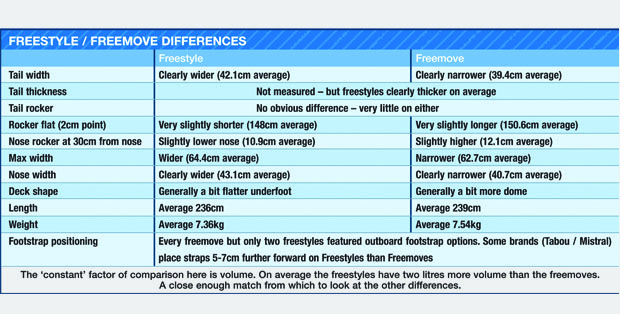
THE TEST
The test was carried out at the OTC centre in Médano, Tenerife. We had plenty of perfect testing conditions with 5.3-6.3m wind from both sides giving flat water and chop / swell on both tacks. Unfortunately the test is not totally comprehensive as there are several other freestyle and freemove boards we didn’t get to try. Most omissions are purely due to lack of availability, although there are no Starboard boards in this test as the importer was unwilling to supply them following their dissatisfaction with the results of the Kombat 89 test in our Nov/Dec issue.
Our grateful thanks to OTC (www.otc-windsurf.com) for all their help. Nearly all the boards tested here are available in the OTC line-up for you to do your own testing, and it’s a great testing venue! Check out their website or contact Sportif (www.sportif-uk.com) for details on OTC Holidays. We can also highly recommend contacting Pauline Martinez for El Médano accommodation, she has a great line-up of villas and apartments in town. (www.martinez.ch, [email protected]). Our pix were taken by ace Polish photographer Andy Jozwik.
THE TEAM
The test was carried out in conjunction with the Polish Windsurfing magazine, giving us a team of four very competent freestylers, and two ‘wannabes’.
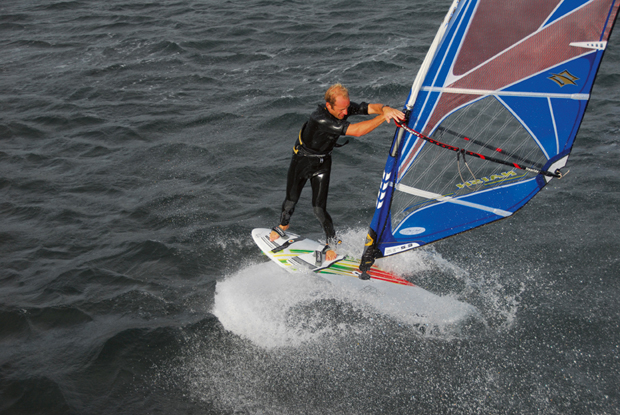
Emile Kott
Aged 29, Emile has worked in Brazil, Egypt, Minorca and England as an instructor. He is an exceptionally ‘one sided’ freestyler and was mightily relieved when the ‘wrong way round’ wind decided to blow! He has vulcans, spocks (with variations) and grubbies dialled on port with occasional flakas. On starboard he can blast quite well (and still looks the part anyway, with bright shorts over his shortie).
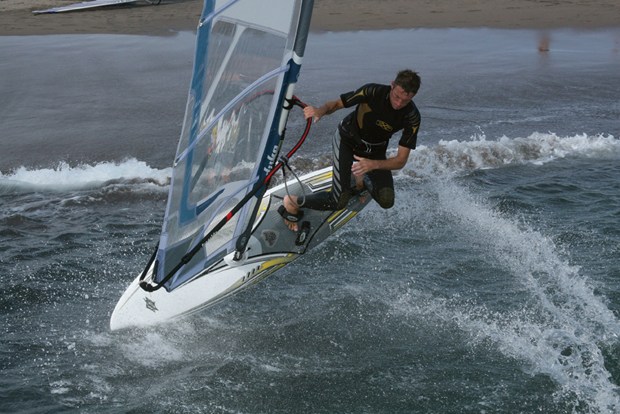
Jono Dunnett
Aged 34, Jono is chief instructor at Minorca Sailing Holidays as well as a successful racer, currently holding the title of Island Games Champion on RS-X boards. Although not quite as one sided as Emile he strongly favours the other tack (so one of them was always moaning). He can break out spocks, grubbies and flakas on starboard, and willy skippers and some obscure Spanish obscenities on port.

Adam Lewis
Aged 19, Adam is a staff member at OTC as well as a member of Team Airborne. He has also worked with Neilson in Dahab and Safeway in Taunton. Adam is a top level sailor – he placed 4th in the Poole Windfest Pro fleet and managed an entry in the PWA event in Tiree, coming =33rd. Being young and vain you seldom see him attempt a move he can actually do, always trying something you can’t possibly recognise, probably switch-stance, one-handed with an outrageous pout for the camera, and always at mach 10. He tells us he is comfortable with flakas, spocks (with variations), grubbies, air-flakas, e-sliders and clew-first punetas. You probably won’t have heard of most of the moves he can pull off occasionally.
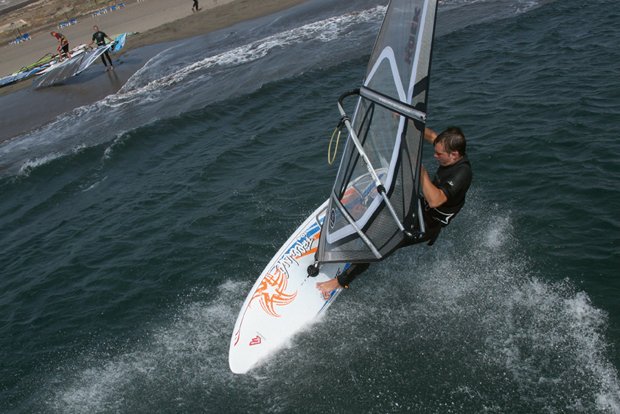
Annek Jozwik
Aged just 17, Annek is the son of our Polish photographer and still at school. Quite the opposite to Adam, Annek is the master of the repeatablemove. Always carrying a sail about 1.5m smaller than everyone else and seldomseeming to plane, he still manages to get pop, slide and spin when it matters and is Mr Freestyle Consistent. Flakas and willy skippers are his moves of the moment but he has many spock variations, old school and wave moves to call on as well.
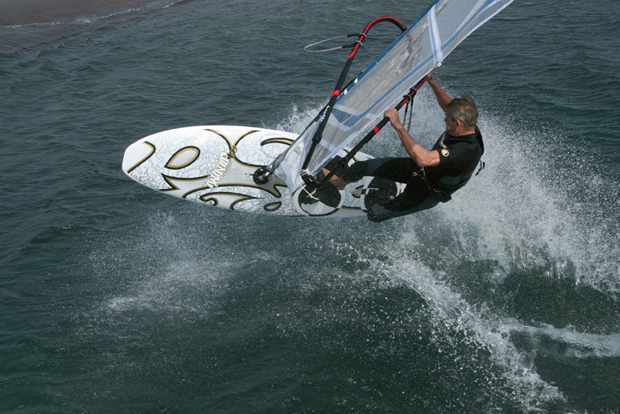
Mariusz & Ian Polish Editor and English Test Editor respectively, Mariusz (above) and Ian (below) consider a duck gybe a pretty good freestyle move. They came along to provide the everyman balance to see how well the freestyles performed for the average non-freestyling sailor, and how much help they offered the fresh freestyle aspirant.

Wot, No Guesters?!?
For the first time in a long time we opted to test without guest testers. This was largely for logistical reasons. Médano becomes a two-venue site when you start looking for flat water, and moving in excess of 10 people with all the attendant de-rigging, re-rigging, transporting and lugging of kit would be a nightmare.

